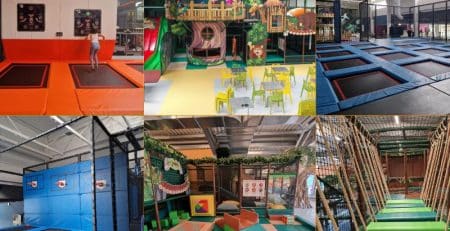How much does a trampoline park cost?
How much does a trampoline park cost? That’s a good question!
 Trampoline parks have become essential attractions in recent years, drawing hundreds of thousands of people of all ages. These indoor play centres offer not only a fun way to exercise but also a space to challenge friends, organize team-building events, and attract a diverse audience. With a notable increase in their popularity, it is crucial for any entrepreneur to understand the precise startup and operating costs involved.
Trampoline parks have become essential attractions in recent years, drawing hundreds of thousands of people of all ages. These indoor play centres offer not only a fun way to exercise but also a space to challenge friends, organize team-building events, and attract a diverse audience. With a notable increase in their popularity, it is crucial for any entrepreneur to understand the precise startup and operating costs involved.
Opening a trampoline park involves a series of significant expenses, ranging from purchasing the equipment and even the building, to renovations and compliance costs, not to mention daily operational costs and regular maintenance.
This article aims to break down the costs of a trampoline park, offering a detailed overview of the necessary investments. You will find tips for planning your budget and strategies to optimize your expenses. Whether you are considering opening your own trampoline park or are simply interested in the cost of such equipment, stay with us for an in-depth approach.
Understanding the initial costs of your trampoline park
Before diving into the details, it is essential to understand the initial costs associated with creating a trampoline park. These expenses can be categorized into four main areas:
Choosing between buying and renting a building
 The choice between buying or renting a building for your trampoline park greatly influences your initial budget. Buying a building offers long-term stability and eliminates the risk of rising rents. However, the initial investment is significantly higher, and you often need to plan for adaptation and renovation work as the building was not originally designed for this activity.
The choice between buying or renting a building for your trampoline park greatly influences your initial budget. Buying a building offers long-term stability and eliminates the risk of rising rents. However, the initial investment is significantly higher, and you often need to plan for adaptation and renovation work as the building was not originally designed for this activity.
Constructing a building with land purchase is generally even more expensive, but you will have exactly the site you need, perfectly adapted to your operation. However, the construction time typically extends the opening of your project by about a year.
On the other hand, renting allows you to start faster and reduces initial expenses, but you will have less flexibility for renovation work. Regardless of your decision, factors such as location, site size, and local market conditions must be carefully evaluated to determine the most profitable option.
Necessary equipment for your trampoline park
 Apart from renovation work depending on the state of the building, trampolines and other gaming equipment constitute a significant part of the material costs. A trampoline park today must offer various activities: free jumping, tumbling lane, basketball, dodgeball, foam pit, airbag, reaper, interactive games, ninja warrior, etc. The cost of a trampoline park ranges from 200,000 to 400,000 euros on average, depending on the size and number of activities.
Apart from renovation work depending on the state of the building, trampolines and other gaming equipment constitute a significant part of the material costs. A trampoline park today must offer various activities: free jumping, tumbling lane, basketball, dodgeball, foam pit, airbag, reaper, interactive games, ninja warrior, etc. The cost of a trampoline park ranges from 200,000 to 400,000 euros on average, depending on the size and number of activities.
Layouts and safety: creating a safe environment for your clients
The costs related to the layout of your trampoline park must take everything into account, from constructing the reception area, snack bar, offices, locker rooms, flooring, lighting, and sound system to installing heating/air conditioning/ventilation systems if the building is not properly equipped. Safety and accessibility standards also require significant investments, including a minimum number of emergency exits, alarm and fire extinguishing systems, and often surveillance cameras.
Operational costs of your trampoline park
Once your trampoline park is set up, you need to consider operational costs. To keep your park profitable, you must manage operating costs, which come in various forms:
Staff: one of the driving forces of the trampoline park
 The success of a trampoline park largely depends on the quality of its staff. Recruitment, training, and salaries form a significant part of operational expenses. You need to hire receptionists, servers, bartenders for the dining area, trampoline supervisors (one for every 32 players), event animators, a manager, and possibly an assistant manager to help manage the entire team.
The success of a trampoline park largely depends on the quality of its staff. Recruitment, training, and salaries form a significant part of operational expenses. You need to hire receptionists, servers, bartenders for the dining area, trampoline supervisors (one for every 32 players), event animators, a manager, and possibly an assistant manager to help manage the entire team.
You must consider the park’s opening hours to know the number of work hours and the necessary number of team members. If you are open more than 70 hours a week, you will need two full teams.
Training is crucial not only for ensuring customer safety but also for providing quality customer service. You will need to hire your employees a few days before the opening. Salaries must be competitive to attract and retain the best talent.
Maintenance: keeping your trampoline park in perfect condition
Maintenance is essential to ensure the safety and proper functioning of the equipment. This includes regular inspections of trampolines, replacement of worn parts, and general building maintenance. In the first years, costs will be low with new materials, but they will rise over the years due to normal wear and tear.
Marketing and advertising: a pillar for successful communication
 In your operating budget, you must also communicate to constantly attract new visitors and retain your clientele. A significant budget must be allocated to marketing and advertising. This can include online advertising campaigns on your social medias, local ads in newspapers or on the radio, participation in events, partnerships, and promotional offers. A well-designed marketing strategy should significantly increase the visibility and appeal of your trampoline park.
In your operating budget, you must also communicate to constantly attract new visitors and retain your clientele. A significant budget must be allocated to marketing and advertising. This can include online advertising campaigns on your social medias, local ads in newspapers or on the radio, participation in events, partnerships, and promotional offers. A well-designed marketing strategy should significantly increase the visibility and appeal of your trampoline park.
Risk management: prevention
Finally, risk management is another important expense item. This includes insurance costs, which are essential to cover your building (theft, water damage, fire, etc.) and your civil liability in case of accidents, and can represent between 5,000 and 10,000 euros per year.
Investing in accident prevention measures, such as staff training and continuous improvement of facilities, can help reduce insurance costs while ensuring everyone’s safety.
Financing strategies for your trampoline park
 To open your trampoline park, knowing your financing options and adopting rigorous budget management is essential to ensure your project’s viability and growth. Here is an overview of financing strategies and some tips for managing your budget effectively.
To open your trampoline park, knowing your financing options and adopting rigorous budget management is essential to ensure your project’s viability and growth. Here is an overview of financing strategies and some tips for managing your budget effectively.
Financing options
When it comes to financing your trampoline park, several options are available:
- Commercial loans: Many financial institutions such as banks offer business loans. Conditions vary, so it is advisable to compare offers to find the most advantageous interest rates and repayment terms.
- Investors: Attracting investors looking to support innovative projects can provide the necessary capital. These investors often plan to exit the capital after a few years with a profit. A shareholder agreement is strongly recommended.
- Grants: Depending on your location and field of activity, government or private grants may be available for certain projects. Inquire with Chambers of Commerce, banks, and your financial partners.
Tips for your trampoline park budget
- Plan meticulously: Establish a detailed budget that includes all the expected and unexpected costs of your trampoline park. Make sure to set aside a margin for unforeseen expenses.
- Track expenses: Use accounting software or customized dashboards to track your expenses in real-time. This will help you stay within your budget limits and adjust your spending if necessary.
- Periodic review: Regularly review your budget to ensure it reflects your business’s current needs and adjust it based on your financial situation’s evolution.
Personalized advice for your future trampoline park
For any future owner considering opening a trampoline park, learning from those who have already gone through this path can be invaluable. Here are some personalized tips:
Advice from Play In Business
- In-depth market study: Before starting, make sure you understand your local market. Knowing the demographics, competition, and preferences of your future customers will help you tailor your offer to better meet customer expectations.
- Rigorous selection of the location: Location is crucial. Look for a site that is easily accessible, visible, and large enough to accommodate your trampoline installations. Proximity to schools and shopping centers is a plus.
- Focus on safety: Never skimp on safety. Investing in quality equipment and rigorous staff training reduces the risk of accidents and builds customer trust.
- Marketing: Develop a creative and targeted marketing strategy. Use social medias to engage your community and consider special offers for first-time customers and group events like team-building sessions.
Create your dream now
 Starting a trampoline park is an exciting adventure that requires a thorough understanding of initial costs, operating expenses, financing options, and effective management strategies. We have explored the importance of choosing the right location, investing in quality equipment, and focusing on safety to ensure an optimal customer experience. Moreover, prudent financial management and a dynamic marketing strategy are crucial for the long-term success of your park.
Starting a trampoline park is an exciting adventure that requires a thorough understanding of initial costs, operating expenses, financing options, and effective management strategies. We have explored the importance of choosing the right location, investing in quality equipment, and focusing on safety to ensure an optimal customer experience. Moreover, prudent financial management and a dynamic marketing strategy are crucial for the long-term success of your park.
Ready to launch your own trampoline park and dive into a market full of potential? Contact us today for tailored advice and start your journey with confidence! For even more tips and essential resources, don’t forget to check out our article: ‘Business Plan: The Ultimate Guide for Your Indoor Playground‘ on our website. Join a booming industry and start your entrepreneurial journey with us by turning your project into a success!






























